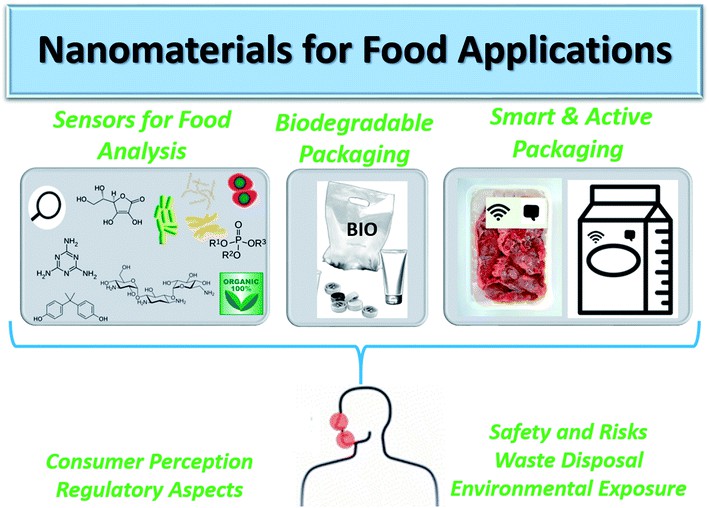Food allergens are very important throughout the food production and supply chain. Traditional methods have some limitations, such as high costs. Therefore, there is a need to establish a simple and easy method for detecting allergens in food. In recent years, nanotechnology has become a highly interdisciplinary field that is rapidly integrating the fields of electronics and surface science, and life sciences. It offers the opportunity to answer questions related to food safety, such as detecting allergenic proteins. The application of nanotechnology in allergen detection mainly involves nanoparticles, of which gold nanoparticles and quantum dots (QDs) are the most commonly used. However, due to these properties, new types of nanoparticles are being developed and applied, and these properties allow for faster, low-cost, sensitive, and specific detection of allergens in food.
 Fig.1. Summary of the applications of nanomaterials in the food sector. (Mustafa F, et al., 2020)
Fig.1. Summary of the applications of nanomaterials in the food sector. (Mustafa F, et al., 2020)
Nanomaterials can be integrated into chemical and biological sensors, enabling the design of fast and sensitive devices to assess freshness and detect allergens, toxins, or disease-causing contaminants. As a global allergen detection company, Lifeasible is dedicated to combining biosensors and nanoparticles to detect allergens in food. Our skilled scientists build nanobiosensor platforms for detecting food allergens with specificity, sensitivity, rapidity, low cost, and field detectability.
Lifeasible offers the following popular nanomaterials:
Lifeasible offers three types of biosensors for the detection of allergens in food:
| Biosensors for Food Allergen Detection | Features of Biosensors |
| Optical Biosensors |
(i) Surface plasmon resonance (SPR) technology-based biosensors are combined with nanomaterials, magnetic nanoparticles, and immunomagnetic methods for qualitative and quantitative detection of food allergens. It allows label-free, real-time detection. (ii) Biosensors with non-SPR technology using DNA arrays can efficiently identify multiple food allergens in a single assay. DNA extracted from contaminated samples can be amplified by PCR to increase sensitivity and specificity. |
| Electromechanical Biosensors | Electromechanical biosensors combined with gold nanoparticles to detect allergens in gluten and shrimp. |
| Electrochemical Biosensors | Electrochemical biosensors offer advanced performance with easy miniaturization, lower cost, and the potential to incorporate additional point of care settings such as wireless food allergen monitoring. The combination of DNA hybridization, nanomaterials, and electrodes can increase surface area and improve conductivity, facilitating quantitative analysis of food allergen DNA. |
We have designed multiple food allergens into biosensors with a range of technical characteristics and detection limits. Lifeasible offers the detection of allergens in the following food.
Based on the different potentials each nanomaterial shows for a specific allergen or class, Lifeasible is committed to providing global customers with the most appropriate nanobiosensors to detect allergens in food. We look forward to working with you, and you will benefit from our one-stop shop for everything from testing and reporting to the highest standards of post-analysis. If you are interested in our services, please feel free to contact us for more information.
Reference
Lifeasible has established a one-stop service platform for plants. In addition to obtaining customized solutions for plant genetic engineering, customers can also conduct follow-up analysis and research on plants through our analysis platform. The analytical services we provide include but are not limited to the following:
Get Latest Lifeasible News and Updates Directly to Your Inbox
Adaptive Evolutionary Mechanism of Plants
February 28, 2025
Unraveling Cotton Development: Insights from Multi-Omics Studies
February 27, 2025